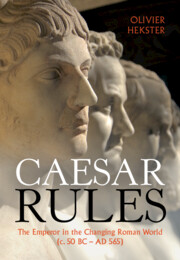Book contents
- Caesar Rules
- Caesar Rules
- Copyright page
- Dedication
- Epigraph
- Contents
- Figures
- Maps
- Graphs
- Preface
- Timeline
- Abbreviations
- Introduction
- 1 Portraying the Roman Emperor
- 2 Playing Imperial Roles
- 3 Being around the Emperor
- 4 The Emperor in the Capital and Provinces
- Conclusions
- Appendix
- Glossary
- Bibliography
- Index of Persons and Places
- General Index
4 - The Emperor in the Capital and Provinces
Published online by Cambridge University Press: 23 November 2022
- Caesar Rules
- Caesar Rules
- Copyright page
- Dedication
- Epigraph
- Contents
- Figures
- Maps
- Graphs
- Preface
- Timeline
- Abbreviations
- Introduction
- 1 Portraying the Roman Emperor
- 2 Playing Imperial Roles
- 3 Being around the Emperor
- 4 The Emperor in the Capital and Provinces
- Conclusions
- Appendix
- Glossary
- Bibliography
- Index of Persons and Places
- General Index
Summary
The Roman emperor ruled one of the largest empires in world history. It consisted of different peoples living in wildly different contexts. They had different expectations of who the emperor was and how he should behave, although the range of those expectations was limited. Views of emperorship were locally dependent. The image of the emperor was not the same throughout the empire, and was often closely bound to his visibility in and his relationship with a specific region. How emperors were represented through statues, historical reliefs, triumphal arches, temples and other monuments, and through the ceremonies that surrounded emperorship, had an enormous impact on how the people who encountered these monuments or participated in these ceremonies perceived their emperors. As the number of monuments accumulated over time, they created an increasingly stable local ‘memoryscape’. Existing imagery influenced both the creation of new local images and the expectations of imperial behaviour.
- Type
- Chapter
- Information
- Caesar RulesThe Emperor in the Changing Roman World (c. 50 BC – AD 565), pp. 260 - 325Publisher: Cambridge University PressPrint publication year: 2022

